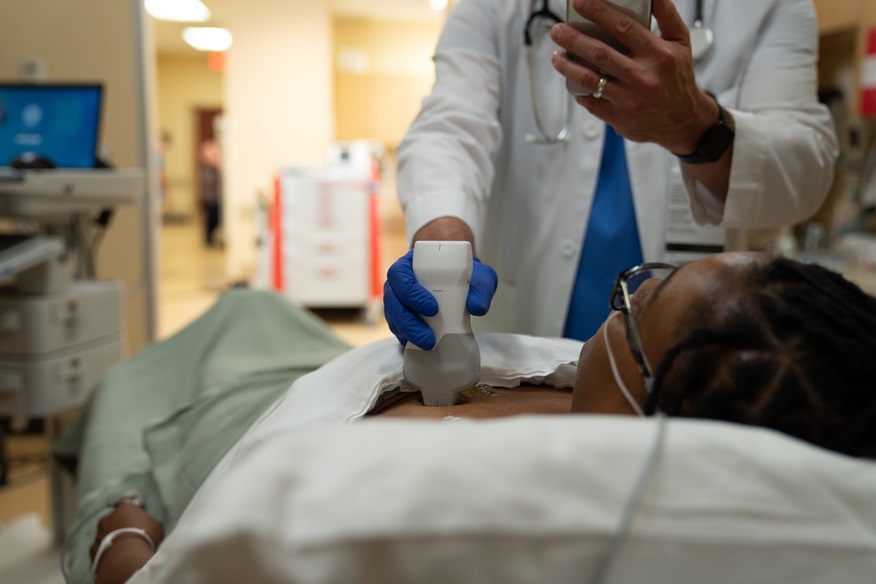This advertorial is sponsored by GE HealthCare
 Experiencing symptoms like chest pain, shortness of breath, nausea or a rapid heartbeat can be extremely scary and overwhelming—especially when it happens out of the blue and due to an unknown cause. Often these symptoms can be the result of a wide range of conditions, including digestive problems, anxiety or stress.
Experiencing symptoms like chest pain, shortness of breath, nausea or a rapid heartbeat can be extremely scary and overwhelming—especially when it happens out of the blue and due to an unknown cause. Often these symptoms can be the result of a wide range of conditions, including digestive problems, anxiety or stress.
However, in some cases these symptoms signal a more serious condion that requires urgent medical attention. Common symptoms of a cardiac issue can vary between genders, and there can also be variability from individual to individual. Importantly, the prevalence of cardiovascular disease is growing indicative of other possible health issues.1
In a heart attack situation, for example, the longer treatment is delayed, the longer the heart muscle goes without oxygen, damaging the cells or even causing them to die.2 This makes prompt diagnosis and treatment vital, because for cardiology paents, me is heart muscle—me is everything.
How traditional diagnosis works today
A trip to the emergency department (ED) can often be complicated and stressful for patients, especially when they present with a potential cardiac event. When a patient arrives at the ED with suspected heart attack, emergency clinicians snap into action to determine the nature and severity of the patient’s case. This requires close teamwork between triage nurses, physicians and other clinicians who will ask the patient or caregiver questions about symptoms, medical history, medications and more, before conducting physical exams and ordering diagnostic tests like electrocardiogram (ECG), blood work, imaging and more. All of this takes me and resources—which are often in short supply in the ED.
Although point-of-care ultrasound has long been a crucial tool for diagnosing heart disease—including cardiac arrest—in the ED, now clinicians have access to handheld, portable, and easy-to-use ultrasound devices designed for cardiac and vascular assessments – and literally fit into a pocket. This technology can help diagnose a patient wherever they are and direct them to appropriate treatment.
The impact of portable ultrasound devices
Handheld, wireless ultrasound offers a practical option that can replace more expensive and less accessible diagnostic imaging, streamlining workflows and reducing demands on already overloaded traditional imaging resources. This allows clinicians to expedite care decisions and help patients receive treatment right away when every second counts.
GE HealthCare pioneered the first colour pocket-sized ultrasound, Vscan, in 2010 and has since continued to revolutionise the way clinicians see patients. In 2021, GE HealthCare launched the Vscan Air CL for abdominal imaging, obstetric assessments, and more, and now they have launched the next innovative generation of handheld ultrasound technology, the Vscan Air SL.
Vscan Air SL is designed to help make it easier to acquire high quality ultrasound images. It is one of the smallest portable, wireless ultrasound devices designed for rapid cardiac and vascular assessments. This allows clinicians to efficiently collect and view cardiac images of patients in real me during a physical exam, helping to accelerate diagnosis and treatment decisions both inside and outside the hospital. To date, there are more than 50,000 systems from the Vscan product suite in the pockets of clinicians, impacting the care of more than an estimated 100 million patients worldwide.
For Steffen Mueller, who leads product development for GE HealthCare’s Vscan product suite, the impact of portable ultrasound devices is personal.
In 2016, clinicians scanned his spouse’s carod artery with Vscan Extend, an earlier version of GE HealthCare’s pocket-sized ultrasound. The image appeared to show a suspicious narrowing, which prompted her to have a comprehensive ultrasound examination by a doctor who confirmed the narrowing as a subtotal occlusion: a dangerous blockage of the blood vessels that can cause a stroke. A few months later, she had an operation that may have saved her live. Handheld ultrasound enabled her care team to catch the narrowing early and take action.
“Our pocket-sized ultrasound may have helped save my wife’s life,” said Steffen. “This experience with my wife inspired me—and my team—to broaden our next generation of handheld ultrasound… to primary care physicians who can apply this quick-look tool to their patients. Vscan Air combines crystal clear
images and the power of a high-performance ultrasound machine in a small, lightweight and wireless dual-probe that enables whole body scanning and comfortably fits in the palm of your hand and in your pocket.”
Ultrasound’s versatility across a variety of care settings
With its combination of portability and image quality, handheld ultrasound is well-positioned to help clinicians conduct cardiac and vascular assessments across a wide variety of diverse care settings, including:
- First Responders – Patients traveling by ambulance are usually experiencing a critical situation that is often life-threatening. When equipped with a technology like Vscan Air SL, EMS teams have a tool in the palm of their hands that can give them a window into a patient’s cardiac anatomy and provide them with answers very quickly, beyond what they can learn from a basic physical exam. This can help to triage the patient while enroute to the hospital so the ED is better informed about the patient’s needs before arrival.
- Emergency Departments– When a patient does present to the ED with a cardiac issue, technologies like Vscan Air SL can provide more specific guidance on is the severity of the individual’s condition, especially when clinicians in the ED setting have limited background on the patient’s symptoms and overall health. These devices allow them to quickly see what is happening inside the patient’s body and evaluate their situation, providing timely information to inform care decisions and proper engagement of key specialists, as needed, to speed time to treatment.
- Mobile Clinics – Mobile clinics are becoming a more popular healthcare model for some patients. In these settings, ultrasounds are key components for care teams, as these devices can provide a lot more information than standard physical examinations and other assessments, which may be limiting. These devices can help providers decide the proper setting and treatment for the patient.
The impact of portable, handheld ultrasound devices on care is poised to be transformative, and GE HealthCare is at the forefront of this innovaon. Read more about Vscan Air SL here.
References
- Chang YJ, Chang SL, Chong E, et al. Cardiovascular Emergencies. Biomed Res Int. 2017; 2017: 7210261. doi: 10.1155/2017/7210261. Epub 2017 Jul 2. PMID: 28752094; PMCID: PMC5511652.
- “Heart Attack (Myocardial Infarction).” Cleveland Clinic. h”ps://my.clevelandclinic.org/health/diseases/16818-heart-a”ackmyocardial-infarcon. Accessed: July 24, 2023
© 2023 GE HealthCare. Vscan Air is a trademark of GE HealthCare. GE is a trademark of General Electric Company used under trademark license. JB25829XX.
Commercial availability of GE HealthCare medical systems is subject to meeting local requirements in a given country or region. Contact a GE HealthCare Representative for more information.
Intended for healthcare professionals only.













